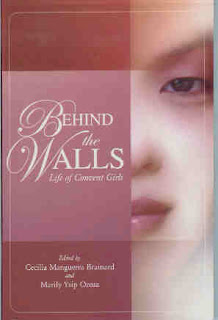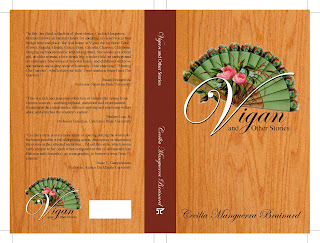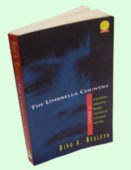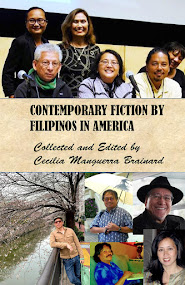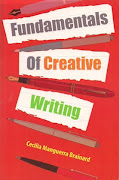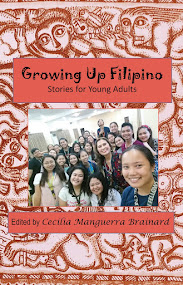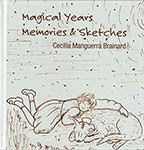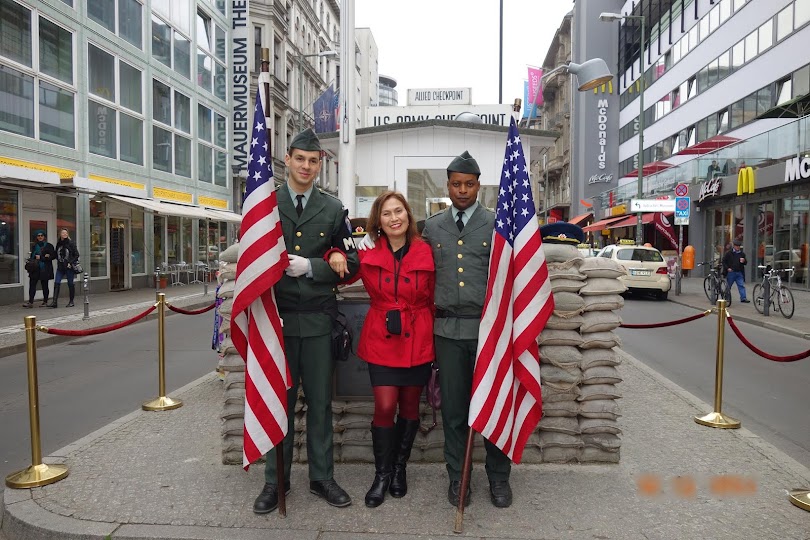I'm reprinting this from:
http://pawainc.blogspot.com/search/label/BooksThis holiday season, why not give the gift of literature? We will be posting reading lists and book buying suggestions from Filipino American authors here. This first one's from Eileen Tabios:
THE CHAINED HAY(NA)KU ANTHOLOGY Curated by Ivy Alvarez, John-Bloomberg Rissman, Ernesto Priego & Eileen Tabios. More info.
ARCHIPELAGO DUST by Karen Llagas (Meritage Press, 2010).
STAGE PRESENCE: CONVERSATIONS WITH FILIPINO-AMERICAN PERFORMING ARTISTS, Ed. Theodore S. Gonzalves (Meritage Press, 2007).
REQUIEM FOR THE ORCHARD by Oliver de la Paz (University of Akron Press, 2010).
TRAJE DE BODA by Aileen Ibardaloza (Meritage Press, 2010).
KALI'S BLADE by Michelle Bautista (Meritage Press, 2006).
THE THORN ROSARY: Selected Prose Poems & New (1996-2010) by Eileen R. Tabios, Edited with an Introduction by Thomas Fink and Afterword by Joi Barrios (Marsh Hawk Press, 2010). I realize I'm citing my book but I really want to draw attention to Dr. Barrios' essay which is useful in terms of discussing Filipina women's poetry. Ordering info: Hardback and Paperback.
PRAU by Jean Vengua (Meritage Press, 2007).
THE TRANSLATOR'S DIARY by Jon Pineda (New Issues Poetry and Prose, 2008). Semi-finalist in very competitive SF State Poetry Center Book Award contest that I judged.
POEMS OF THE BLACK OBJECT by Ronaldo Wilson (Futurepoem Books, 2009). Winner of 2010 AAWW Poetry Award that I judged with John Yau and Sesshu Foster.
DIWATA by Barbara Jane Reyes (BOA Editions, 2010).
~~~
Luis Francia: Holiday Gift Book List
The Beauty of Ghosts, by Luis H. Francia (Manila: Ateneo de Manila University Press, 2010). (Order at Philippine Expressions.)
Autobiography of Mark Twain: The Complete and Authoritative Edition, Vol. 1 (Berkeley: University of California Press, 2010).
Haywire: Flash Fictions, by Thaddeus Rutkowski (New York: Starcherone/Dzanc Books, 2010).
Poems of the Black Object, by Ronaldo Wilson (New York: Futurepoems Books, 2009).
Ilustrado, by Miguel Syjuco (New York: Farrar Straus & Giroux, 2010).
The Verso Book of Dissent: From Spartacus to the Shoe Thrower in Baghdad, edited by A. Hsiao & A. Lim (New York: Verso Books, 2010).
~~~~~
This list is from Karen Llagas:
Baker of Tarifa by Shadab Zeest Hashmi (Poetic Matrix Press, 2010).
Bulaklak sa Tubig: Mga Tula ng Pag-ibig at Himagsik / Flowers on Water: Poems on Love and Revolt by Joi Barrios (bi-lingual, Tagalog-English; Anvil Publishing, 2010).
The Place That Inhabits Us: Poems of the San Francisco Bay Watershed, edited by Sixteen Rivers Press (Sixteen Rivers Press, 2010).
Independence, by Sarah Lapido Manyika (Legend Press, 2008).
Crown of Dust, by Mary Volmer (Soho Press, 2010).
A Thousand Threads, by Steve Orlen (The Hollyridge Press Chapbook Series, 2009).
~~~~~
This list is from Veronica Montes:
What It Is (Drawn & Quarterly, 2008) and Picture This: The Near-Sighted Monkey Book (Drawn & Quarterly, 2010) by Lynda Barry. Writers and artists will be inspired by these two unorthodox “manuals” for the creative life. Written by hand and filled with Barry’s color-saturated collages, drawings, doodles, and whatnot, they're pretty much impossible to put down.
Pinoy Capital: The Filipino Nation in Daly City, by Benito M. Vergara, Jr. (Temple University Press, 2009). Like thousands of Filipinos before me, and hundreds of thousands after me, I grew up in Daly City. This is a fascinating anthropological take on my hometown, written in a style that is somehow both academic and conversational. A must-have for the bookshelf of anyone with even a tangential interest in a landscape that holds special meaning for Filipinos.
A History of the Philippines from Indios Bravos to Filipinos by Luis Francia (Overlook Press, 2010). A history of the Philippines written by a poet/journalist? Who could resist such a fine book? Pick up two copies: one for yourself, and one to offer as a gift to someone who has been very, very good this year.
Imago by Joseph O. Legaspi (CavanKerry Press, 2007). I had the chance to hear Joseph read from the poems in Imago when he participated in the PAWA Reading Series earlier this year, and was instantly drawn to his work. He captures all the beauty and innocence of childhood, tempered by the inevitable intrusion(s) of death, violence, sex (the confusing parts, that is). So good.
Diwata by Barbara Jane Reyes (BOA Editions, Ltd., 2010). Lush, lovely, inspired. These poems are filled with startling imagery, strong women, and story, story, story.
The Solemn Lantern Maker, by Merlinda Bobis (Delta, 2009). This novel begins just six days before Christmas with a mute boy trawling the streets selling his handmade paper lanterns. Add to this his best friend Elvis (who holds a terrible secret), an injured and missing American tourist, and a post-9/11 let’s-freak-everybody-out media frenzy, and what do you have? A really good story.
Growing Up Filipino II: More Stories for Young Adults, Cecilia Brainard, ed. (PALH Books, 2009). I would recommend this anthology even if I didn’t have a story in it. It’s one of those books I’d wished I’d had as a teenager and young adult, simply because it’s affirming to have our experiences transformed into a narrative on the page. You’ll find bits and pieces of yourself and yours in these stories, for sure.
I’d also like to recommend subscriptions to literary journals that seem to consistently support the work of Filipino writers. Bamboo Ridge Press, The Asian American Literary Review, and Manoa instantly come to mind.
~~~~~
Here's Vangie Buell's:
Sky High: The True Story of Maggie Gee, by Marissa Moss, illustrated by Carl Angel (Tricycle Press, 2009).
Cora Cooks Pancit, by Dorina K. Lazo Gilmore, illustrated by Kristi Valiant (Shen's Books, 2009).
Twenty Five Chickens and a Pig for a Bride: Growing up in an Filipino Immigrant Family, by Evangeline Canonizado Buell, illustrated by Carl Angel (T'Boli Publishing, 2006).
Images of America: Filipinos in the East Bay, by Evangeline Canonizado Buell, Evelyn Luluquisen, Ellie Luis, and Lillian Galledo (Arcadia Publishing, 2008).
Look for these books at Arkipelago Books and Eastwind Books of Berkeley.
~~~~
Here are Oliver de la Paz's recommendations:
In Canaan, by Shane McCrae (Rescue Press, 2010).
Burnings, by Ocean Vuong (Sibling Rivalry Press, 2010).
Each Crumbling House, by Melody S. Gee (Perugia Press, 2010).
Sweet Grass, by Micah Ling (Sunnyoutside Press, 2010).
~~~~~
Here's Barbara Jane Reye's list:
Lola: A Ghost Story, by J. Torres and Elbert Or (Oni Press, 2010).
Growing Up Filipino II: More Stories for Young Adults, edited by Cecilia Brainard (PALH Books, 2010).
breaking poems (Cypher Books, 2008), and Born Palestinian, Born Black (UpSet Press, 2010), by Suheir Hammad.
A History of the Philippines: From Indios Bravos to Filipinos (Overlook Press, 2010), and Eye of the Fish: A Personal Archipelago (Kaya Press, 2001), by Luis Francia.
The Solemn Lantern Maker (Delta, 2009), and Banana Heart Summer (Delta, 2008), by Merlinda Bobis.
In the Company of Strangers, by Michelle Cruz Skinner (Bamboo Ridge Press, 2009).
The Salt-Wind, Ka Makani Pa'akai, by Brandy Nalani McDougall (Kuleana 'Oiwi Press, 2009).
Outlaw: The Collected Works of Miguel Piñero (Arte Publico Press, 2010).
The Gods We Worship Live Next Door, by Bino A. Realuyo (University of Utah Press, 2006).
from unincorporated territory [saina], by Craig Santos Perez (Omnidawn Press, 2010).
Up Jump the Boogie, by John Murillo (Cypher Books, 2010).
Migritude, by Shailja Patel (Kaya Press, 2010).
Also remember, you can shop online at Arkipelago Books and Eastwind Books of Berkeley.
~~~
~~~~
Cecilia's List:
Lim, Paulino, Jr. REQUIEM FOR A REBEL PRIEST. New Day, 1996, First Edition, softcover, 225 pp., Paulino Lim is a professor of English at Cal State Long Beach.You can read his short story, Curacao Cure, in Our Own Voice (March 2002) http://www.oovrag.com/stories/stories2002a-3.shtml, Requiem for a Rebel Priest is his 3rd novel of a trilogy set during the Marcos and Aquino regimes follows the return of an ex-Jesuit to the Philippines when restless segments of the military were attempting to overthrow the Aquino government. You can find this and his other books in amazon.com
Ty-Casper, Linda. DREAM EDEN. Ateneo de Manila University Press, 1996, First Edition, softcover, 460 pp.,
One of the most prolific Filipino American writers is Linda Ty Casper who has written over 15 books. She is one author who should be admired not only for her talent but for her grace. This novel by Linda Ty-Casper is a portrait of the Philippines just before the Peaceful Revolution of 1986 up to the last coup of 1989.
Ty-Casper, Linda. AWAITING TRESPASS. New Day, 1989, First Edition, softcover, 180 pp.,
New York Times Book Review says: "Linda Ty-Casper pulls no punches in this unusual novel, which she describes as "a pasión" - yet she wears silk gloves. With jobs so deft they avoid the didactic but sting mightily, she indicts everything, from the values of the well-to-do to martial law.."
Brainard, Cuizon, Evangelista, Montes, and Sarreal. ANGELICA'S DAUGHTERS, A DUGTUNGAN NOVEL. Anvil, 2010, First Edition, softcover, newsprint, 200 pp,
Angelica's Daughters is a collaborative novel by five established Filipina writers, called a "dugtungan." A dugtungan is a genre of Tagalog novel popular early in the 20th century, in which each writer creates a chapter and hands it off to the next, who writes another chapter without direction. The result, in this case, is an ensemble performance that contains something of the exhilaration of theatrical improv. One watches these accomplished authors inventively weave a historical romance, creating gripping heroines and turns of plot, crossing decades and national boundaries, tapping into cultural roots of the Philippines, Spain and America. Reading Angelica's Daughters is a gripping experience.~ Brian Ascalon Roley, Author of American Son (W.W. Norton)
Briones, Concepcion G. LIFE IN OLD PARIAN. Kaguiakan 2000, softcover, new, 99 pages.
I love this hard to find book about historic old Cebu, especially because the Parian district is undergoing gentrification. Concepcion Briones writes about growing up in the old Parian district of Cebu. She writes about the old families who lived there; she describes the houses and landmarks of the place; she records gossip of the time. This book is a must-read for anyone interested in Cebu.
Evangelista, Susan. GROWING INTO ASIA AND OTHER ESSAYS. UP Press, First Edition, softcover, 102 pp.
This is a collection of charming and insightful essays by Susan Evangelista who straddles many worlds. She hails from Michigan but is married to a Filipino. She has traveled to Japan, China, Thailand, Cambodia, and many other places. In this collection, she explores her life as an American in the Philippines, and reflects on the many other facets of her fascinating life. Evangelista taught writing and literature at the Ateneo de Manila.














